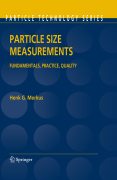
This book focuses on the practical aspects of particle size measurement: a major difference with existing books, which have a more theoretical approach. Ofcourse, the emphasis still lies on the measurement techniques. For optimum application, their theoretical background is accompanied by quantitative qualityaspects, limitations and problem identification. In addition the book covers the phenomena of sampling and dispersion of powders, either of which may be dominant in the overall analysis error. Moreover, there are chapters on the general aspects of quality for particle size analysis, quality management, reference materials and written standards, in- and on-line measurement, definitions and multilingual terminology, and on the statistics required for adequate interpretation of results. Importantly, a relation is made to product performance, both during processing as well as in final application. In view of its set-up,this book is well suited to support particle size measurement courses. The essential practical guide to particle size analysis techniques Equally useful toexperienced practitioners and novices INDICE: Preface. 1: Introduction. 2: Particle size, size distributions andshape. 3: Quality aspects in particulate analysis. 4: Sampling. 5: Dispersion. 6: Overview of size characterization methods. 7: Microscopy and image analysis. 8: Sieving. 9: Electrical sensing zone. 10: Laser diffraction. 11: Ultrasound extinction. 12: Dynamic light scattering. 13: Sedimentation. 14: In- and on-line measurement. 15: Written standards. 16: Reference materials. 17: Quality management and calibration. 18: Definitions and symbols. 19: Multilingual terminology. 20: Statistical background. Annex I. Names and addresses of institutes and companies. Subject index.
- ISBN: 978-1-4020-9015-8
- Editorial: Springer
- Encuadernacion: Cartoné
- Páginas: 410
- Fecha Publicación: 01/10/2008
- Nº Volúmenes: 1
- Idioma: Inglés
